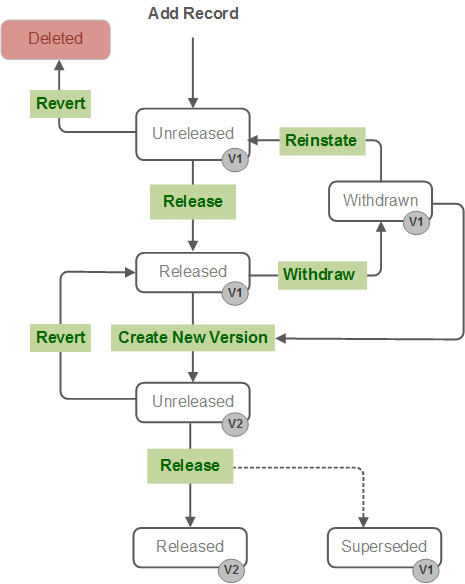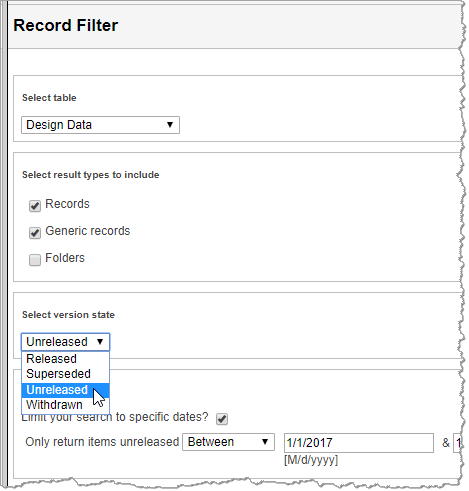
Version control can be enabled on a table by the GRANTA MI administrator in MI:Admin. In version-controlled tables:
Once version control has been enabled for a table, each record and generic folder in the table has a version control 'state'.
| Version state | Description |
|---|---|
| Unreleased | This is the 'unapproved' version of the record. Unreleased
records
|
| Released | This is the 'approved' version. Approved records
|
| Superseded | This is a released version of the record that has been 'superseded'
by a later released version. Superceded records:
|
| Withdrawn | This is a released version of the record that has been 'withdrawn'
from use. Withdrawn records
|
When version control is enabled for a table, records may be moved from one state to another as follows (you can click on the image to view the relevant help topic):

These operations are covered in the following topics:
Note also that the Bulk Edit Version Control tool can be used to Release, Revert, Withdraw, or Reinstate a number of records at the same time.
Attribute data and metadata values in versioned records have an explicit version number. The attribute data version is related to the record version, and can be considered a sub-feature of the record version
Each attribute data value in a record has a version number that is incremented if the data value has been changed since the previous version of the record was released.
Between different versions of a record, the data for any specific attribute may be unchanged, and thus the same version of the data may be shared by multiple record versions.
Example: a record with eight different versions, might have only three versions of data for an attribute:
Record version |
1 |
2 |
3 |
4 |
5 |
6 |
7 |
8 |
Data version |
1 |
2 |
3 |
|||||
The data version number may lag behind the record version number. It will never be greater than the record version number.
If version control has not been enabled for a table, none of data in the table has a version number.
Attribute data values do not have a version state
Action |
Description |
|---|---|
Adding a new record |
When the data is created in the unreleased record, it is given a version number of 1. |
Editing an unreleased record |
The data version number in an unreleased record is only incremented once, the first time the data is changed. After that, the data may be edited multiple times without incrementing the version number with every subsequent edit Editing the metadata for an attribute does not affect the version number of the attribute data, only that of the metadata. |
Releasing a record |
When the record is released, the value for that data version is fixed. The data version number is not incremented. |
Some additional information is stored in the database with records and data as a result of version control.
| Setting | Description |
|---|---|
| Version Number | Each record in the database will have a version number. When the record is created it is given a version number of 1. Each time a new unreleased instance of the record is created, the version number is incremented. Data within the record displays the same version number as the instance of the record. |
| Date of Operation
User Login |
Whenever the version control state of a record changes, the date of the change and the login of the user who made the change are stored. As some operations result in multiple state changes, some dates will be identical. For example, after a 'release' operation, the date of release of the new version and the date the old version was superseded will be identical. |
| Version Notes | Whenever the version control state of a record changes, the user making the change can enter some explanatory text. The presence of this text is optional. |
| Change Notes | Each time a record or its data is edited, the user making the change can enter some explanatory text. The presence of this text is optional. This information is stored in the database, however, at the present time, it cannot be displayed. |
You can search for records by version state using the Record Filter. For example:
